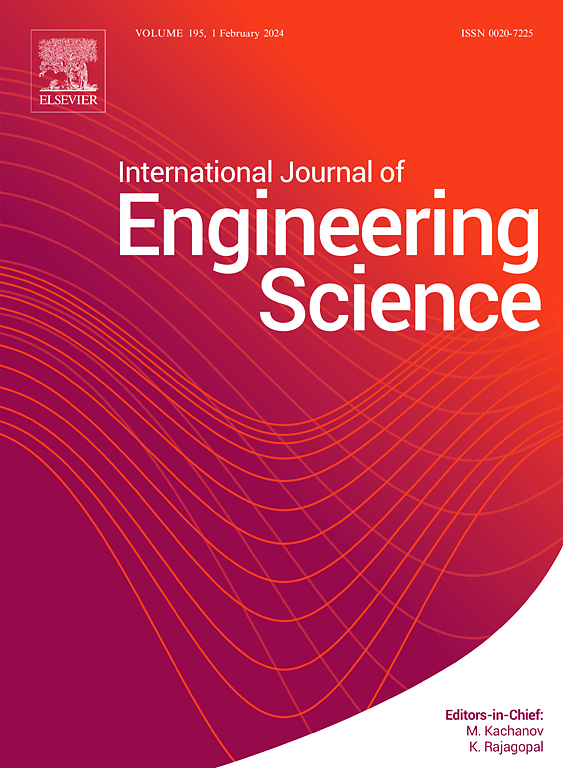Enhancement of magnetoelectric effect in polymeric matrix composites by periodically-poled checkerboard structure
IF 5.7
1区 工程技术
Q1 ENGINEERING, MULTIDISCIPLINARY
International Journal of Engineering Science
Pub Date : 2025-03-23
DOI:10.1016/j.ijengsci.2025.104258
引用次数: 0
Abstract
A multiscale simulation was carried out using a two-stage homogenization process to improve the performance of flexible, printable magnetoelectric (ME) polymer matrix composites. A periodically-poled checkerboard structure discovered in the multiscale optimum design of ceramic composites was applied to particle-dispersed polymer matrix composites, targeting a composite of piezomagnetic (PM) cobalt ferrite and piezoelectric (PE) barium titanate, and its effect was computationally verified. As a result, the periodically-poled reversal checkerboard structure improved the transverse ME constant by approximately 8.3 times compared to a conventional laminated structure. In addition, we investigated the effect of the matrix polymer Young's modulus (Em) on the ME constant as a new design variable. Due to the trade-off between strain transfer and PM and PE properties, the multiscale simulation showed that the maximum value of the transverse ME constant exists when Em is in the range of 1–2 GPa.
利用周期性极化棋盘结构增强聚合物基复合材料中的磁电效应
为了提高柔性可打印磁电聚合物基复合材料的性能,采用两阶段均质工艺进行了多尺度模拟。将陶瓷复合材料多尺度优化设计中发现的周期性极化棋盘结构应用于颗粒分散聚合物基复合材料,以压磁性(PM)钴铁氧体与压电(PE)钛酸钡复合材料为研究对象,并对其效果进行了计算验证。结果表明,与传统的层压结构相比,周期性极化反转棋盘结构的横向ME常数提高了约8.3倍。此外,我们研究了基体聚合物的杨氏模量(Em)对ME常数作为一个新的设计变量的影响。由于应变传递与PM和PE性能之间的权衡,多尺度模拟表明,当Em在1 ~ 2 GPa范围内时,横向ME常数存在最大值。
本文章由计算机程序翻译,如有差异,请以英文原文为准。
求助全文
约1分钟内获得全文
求助全文
来源期刊

International Journal of Engineering Science
工程技术-工程:综合
CiteScore
11.80
自引率
16.70%
发文量
86
审稿时长
45 days
期刊介绍:
The International Journal of Engineering Science is not limited to a specific aspect of science and engineering but is instead devoted to a wide range of subfields in the engineering sciences. While it encourages a broad spectrum of contribution in the engineering sciences, its core interest lies in issues concerning material modeling and response. Articles of interdisciplinary nature are particularly welcome.
The primary goal of the new editors is to maintain high quality of publications. There will be a commitment to expediting the time taken for the publication of the papers. The articles that are sent for reviews will have names of the authors deleted with a view towards enhancing the objectivity and fairness of the review process.
Articles that are devoted to the purely mathematical aspects without a discussion of the physical implications of the results or the consideration of specific examples are discouraged. Articles concerning material science should not be limited merely to a description and recording of observations but should contain theoretical or quantitative discussion of the results.
 求助内容:
求助内容: 应助结果提醒方式:
应助结果提醒方式:


